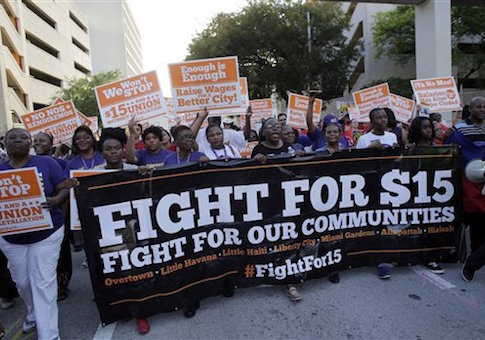Big Labor’s battle against the One Percent does not appear to include 10 union officials who are better paid than the average American CEO, according to a new study released Wednesday.
The Center for Union Facts (CUF), a labor watchdog, identified 162 union presidents that receive compensation packages in excess of the $180,700 average take home pay that business chief executives earn. The report also identifies 10 union presidents—none of whom returned request for comment—who earn more than double that figure.
United Food and Commercial Workers Local 464 President John T. Niccollai was the highest paid union official in 2014, according to federal labor filings. He earned about $575,000 for representing 16,000 grocery store workers in New Jersey. Those workers pay the union nearly $500 in annual dues and anywhere from $50 to $150 for initiation fees.
Niccollai made headlines in September when he slammed convicted embezzler John R. Moritz, a former A&P marketing executive.
"When I look at what we could have done with this money in terms of getting some of those [contract concessions] back, I find it appalling," he told NorthJersey.com after Moritz was sentenced to three years in prison.
Niccollai has lamented "concessions to save A&P/Pathmark and save our union members’ jobs" on the local union’s website. He has also raised dues by about 6 percent since 2013.
More than 7 percent of all dues and fees collected by the union were used to pay Nicollai’s single salary. He and two deputies were paid $1.3 million combined, while the rest of his staff accounted for $2.1 million in pay. His son, John Niccollai III, was the highest paid staffer, garnering a $245,000 salary.
The $3.4 million the union spent on salaries alone is nearly $500,000 more than it spent on representational activities on the year.
Nine other union presidents received pay packages in excess of $370,000. American Federation of Teachers President Randi Weingarten rounded out the top-10 list with a salary of $375,174, according to that union’s most recent report.
Rick Berman, executive director of the Center for Union Facts, said the high salaries demonstrate the hypocrisy of union leaders who make a living condemning business owners.
"If Big Labor is interested in turning a skeptical eye on executive pay, it should start with the one-percenters in its own ranks. Dues payments from middle-class employees are funding six-figure pay packages for hundreds of union presidents," Berman said.
Salary is not the only factor that goes into the CUF analysis. Weingarten, for example, is the fifth-highest compensated union executive when all benefits and perks are taken into account. Niccollai’s high salary comes with about $6,000 in spending money, a paltry sum compared to the overall highest-paid union official, Laborers International Union of North America President Terrence O’Sullivan. Only $487,000 out of O’Sullivan’s $670,000 compensation package comes from his salary. The rest comes from reimbursed expenses and other perks.
Patrick Semmens, spokesman for the National Right to Work Committee, said there is one key difference between CEOs and union officers. Company officials derive their incomes from business performance, but union organizers receive theirs from the paychecks of workers.
"The real scandal here is that union bosses fund their often lavish salaries with dues and fees taken from workers who would be fired for refusing to pay," he said.
"Union officials should work for the rank-and-file workers, but with forced union dues employees instead end up working for the benefit of union officials."
